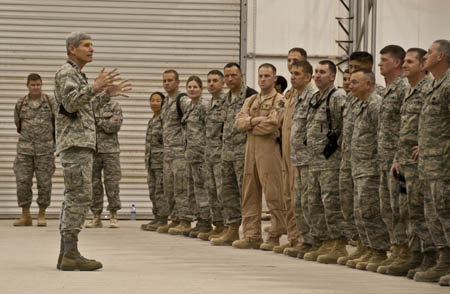The United States should adopt a new nuclear posture that eliminates its first-strike capability by reducing the strategic arsenal to 900 warheads or less, said retired Marine Corps Gen.
James Cartwright, former Joint Chiefs vice chairman, in a media teleconference May 16. "It is a significant departure from our posture [and] it is one that we would have to enter into with the Russians," explained Cartwright in introducing the Global Zero initiative's
new report (caution, large-sized file) advocating this new doctrine and structure. "We're talking about having about 300 weapons . . . that are available at any given time . . . so the numbers are not there for the pre-emptive, decapitating strike," he stressed. Cartwright further advocated eliminating the ICBM force, asserting that fixed missile sites are "malpositioned" and "vulnerable" in comparison to ballistic missile submarines and the strategic bomber force. Asked for comment during a May 16 appearance at the Brookings Institute in Washington, D.C., Air Force Chief of Staff Gen. Norton Schwartz said "Cartwright's supposition is farfetched and it introduces the likelihood of instability in a deterrence equation, which is not healthy." Schwartz added: "I don't agree with his assessment, nor the study that is referenced."
 Air Force Chief of Staff Gen. Norton Schwartz and Chief of Naval Operations Adm. Jonathan Greenert attempted to break down the AirSea Battle initiative during a joint discussion at the Brookings Institution in Washington, D.C., May 16. AirSea Battle is more of a mindset really intended to guide the Air Force and Navy to "unprecedented" levels of collaboration and cooperation that will preserve US access to air and maritime commons, they said. "We're not thinking about things in the 'airman' and 'sailor' stovepipes anymore," said Schwartz. Furthermore, attempts by many to connect the concept strictly to China's growing military prowess are misguided at best, he added. "This solution should not be hijacked by any particular scenario," said Schwartz. Greenert said limiting the concept to a particular region would be "short-sighted" and a "mistake." "We would like to make this cross-domain operation more of an assumption for the future," he said. One example of such collaboration, said Greenert, could include using a submarine to defeat an enemy's air defenses, either kinetically or through electronic countermeasures. "The idea is to broaden the aperture and make that the standard approach," said Greenert. (Schwartz's prepared remarks) (Brookings webpage with event audio)
Air Force Chief of Staff Gen. Norton Schwartz and Chief of Naval Operations Adm. Jonathan Greenert attempted to break down the AirSea Battle initiative during a joint discussion at the Brookings Institution in Washington, D.C., May 16. AirSea Battle is more of a mindset really intended to guide the Air Force and Navy to "unprecedented" levels of collaboration and cooperation that will preserve US access to air and maritime commons, they said. "We're not thinking about things in the 'airman' and 'sailor' stovepipes anymore," said Schwartz. Furthermore, attempts by many to connect the concept strictly to China's growing military prowess are misguided at best, he added. "This solution should not be hijacked by any particular scenario," said Schwartz. Greenert said limiting the concept to a particular region would be "short-sighted" and a "mistake." "We would like to make this cross-domain operation more of an assumption for the future," he said. One example of such collaboration, said Greenert, could include using a submarine to defeat an enemy's air defenses, either kinetically or through electronic countermeasures. "The idea is to broaden the aperture and make that the standard approach," said Greenert. (Schwartz's prepared remarks) (Brookings webpage with event audio)
